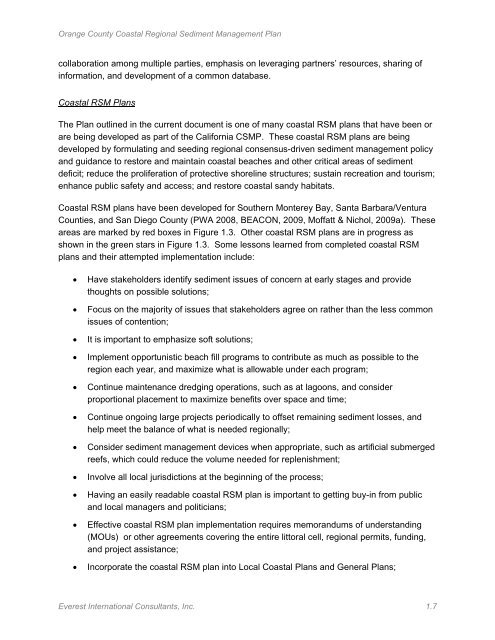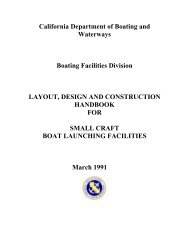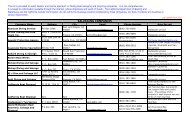EVEREST June, 2013 - California Department of Boating and ...
EVEREST June, 2013 - California Department of Boating and ...
EVEREST June, 2013 - California Department of Boating and ...
You also want an ePaper? Increase the reach of your titles
YUMPU automatically turns print PDFs into web optimized ePapers that Google loves.
Orange County Coastal Regional Sediment Management Plan<br />
collaboration among multiple parties, emphasis on leveraging partners’ resources, sharing <strong>of</strong><br />
information, <strong>and</strong> development <strong>of</strong> a common database.<br />
Coastal RSM Plans<br />
The Plan outlined in the current document is one <strong>of</strong> many coastal RSM plans that have been or<br />
are being developed as part <strong>of</strong> the <strong>California</strong> CSMP. These coastal RSM plans are being<br />
developed by formulating <strong>and</strong> seeding regional consensus-driven sediment management policy<br />
<strong>and</strong> guidance to restore <strong>and</strong> maintain coastal beaches <strong>and</strong> other critical areas <strong>of</strong> sediment<br />
deficit; reduce the proliferation <strong>of</strong> protective shoreline structures; sustain recreation <strong>and</strong> tourism;<br />
enhance public safety <strong>and</strong> access; <strong>and</strong> restore coastal s<strong>and</strong>y habitats.<br />
Coastal RSM plans have been developed for Southern Monterey Bay, Santa Barbara/Ventura<br />
Counties, <strong>and</strong> San Diego County (PWA 2008, BEACON, 2009, M<strong>of</strong>fatt & Nichol, 2009a). These<br />
areas are marked by red boxes in Figure 1.3. Other coastal RSM plans are in progress as<br />
shown in the green stars in Figure 1.3. Some lessons learned from completed coastal RSM<br />
plans <strong>and</strong> their attempted implementation include:<br />
• Have stakeholders identify sediment issues <strong>of</strong> concern at early stages <strong>and</strong> provide<br />
thoughts on possible solutions;<br />
• Focus on the majority <strong>of</strong> issues that stakeholders agree on rather than the less common<br />
issues <strong>of</strong> contention;<br />
• It is important to emphasize s<strong>of</strong>t solutions;<br />
• Implement opportunistic beach fill programs to contribute as much as possible to the<br />
region each year, <strong>and</strong> maximize what is allowable under each program;<br />
• Continue maintenance dredging operations, such as at lagoons, <strong>and</strong> consider<br />
proportional placement to maximize benefits over space <strong>and</strong> time;<br />
• Continue ongoing large projects periodically to <strong>of</strong>fset remaining sediment losses, <strong>and</strong><br />
help meet the balance <strong>of</strong> what is needed regionally;<br />
• Consider sediment management devices when appropriate, such as artificial submerged<br />
reefs, which could reduce the volume needed for replenishment;<br />
• Involve all local jurisdictions at the beginning <strong>of</strong> the process;<br />
• Having an easily readable coastal RSM plan is important to getting buy-in from public<br />
<strong>and</strong> local managers <strong>and</strong> politicians;<br />
• Effective coastal RSM plan implementation requires memor<strong>and</strong>ums <strong>of</strong> underst<strong>and</strong>ing<br />
(MOUs) or other agreements covering the entire littoral cell, regional permits, funding,<br />
<strong>and</strong> project assistance;<br />
• Incorporate the coastal RSM plan into Local Coastal Plans <strong>and</strong> General Plans;<br />
Everest International Consultants, Inc. 1.7




